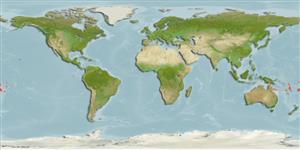Classification / Names
Nombres comunes | Sinónimos | Catalog of Fishes(Género, Especie) | ITIS | CoL | WoRMS | Cloffa
>
Perciformes/Uranoscopoidei (Sand dwellers) >
Pinguipedidae (Sandperches)
Etymology: Parapercis: Greek, para = the side of + Greek, perke = perch (Ref. 45335); xanthogramma: Named for the yellow bands on the cheek region of the males..
Environment: milieu / climate zone / depth range / distribution range
Ecología
marino bentopelágico; rango de profundidad 0 - 6 m (Ref. 75058). Tropical
Distribución
Países | Áreas FAO | Ecosistemas | Ocurrencias, apariciones | Point map | Introducciones | Faunafri
Central Pacific: Fiji, Tonga and Western Samoa.
Tamaño / Peso / Age
Maturity: Lm ? range ? - ? cm
Max length : 17.4 cm SL macho / no sexado; (Ref. 75058); 15.8 cm SL (female)
Short description
Morfología | Morfometría
Espinas dorsales (total): 5; Radios blandos dorsales (total): 21; Espinas anales 1; Radios blandos anales: 17. This species is distinguished by the following characters: pectoral fin rays, usually 18; cheek region with 4-7 oblique, pale (yellow when fresh) entire bands; lower portion of the body in males with 3-4 ocelli and a series of several blackish and brownish spots; cheek region with B5 spot, 6-8 ocelli and brownish spots or patches between ocelli in females and juveniles (Ref. 75058).
Life cycle and mating behavior
Madurez | Reproducción | Puesta | Huevos | Fecundidad | Larva
Imamura, H. and T. Yoshino, 2007. Three new species of the genus Parapercis from the Western Pacific, with Rediscription of Parapercis hexophtalma (Perciformes:Pinguipedidae). Bull. Natl. Mus. Nat. Sci. Ser. A, Suppl. 1:81-100. (Ref. 75058)
IUCN Red List Status (Ref. 130435)
Threat to humans
Harmless
Human uses
Más información
PaísesÁreas FAOEcosistemasOcurrencias, aparicionesIntroduccionesStocksEcologíaDietacomponentes alimenticiosconsumo de alimentoRación
Nombres comunesSinónimosMetabolismoDespredadoresEcotoxicologíaReproducciónMadurezPuestaAgregación para la puestaFecundidadHuevosEgg development
Age/SizeCrecimientoLength-weightLength-lengthLength-frequenciesMorfometríaMorfologíaLarvaDinámica larvariaReclutamientoAbundanciaBRUVS
ReferenciasAcuiculturaPerfil de acuiculturaRazasGenéticaElectrophoresesheritabilidadEnfermedadesProcesamientoNutrientsMass conversion
ColaboradoresImágenesStamps, Coins Misc.SonidosCiguateraVelocidadTipo de nataciónSuperficie branquialOtolitosCerebrosVisión
Herramientas
Special reports
Download XML
Fuentes de Internet
Estimates based on models
Preferred temperature (Ref.
123201): 25.8 - 29, mean 27.1 °C (based on 233 cells).
Phylogenetic diversity index (Ref.
82804): PD
50 = 0.5000 [Uniqueness, from 0.5 = low to 2.0 = high].
Bayesian length-weight: a=0.00692 (0.00311 - 0.01538), b=3.06 (2.88 - 3.24), in cm total length, based on LWR estimates for this Genus-body shape (Ref.
93245).
Nivel trófico (Ref.
69278): 3.5 ±0.4 se; based on size and trophs of closest relatives
Resiliencia (Ref.
120179): Alto, población duplicada en un tiempo mínimo inferior a 15 meses (Preliminary K or Fecundity.).
Fishing Vulnerability (Ref.
59153): Low vulnerability (11 of 100).
Nutrients (Ref.
124155): Calcium = 212 [122, 386] mg/100g; Iron = 1.01 [0.56, 1.72] mg/100g; Protein = 16.8 [14.7, 18.8] %; Omega3 = 0.13 [0.06, 0.27] g/100g; Selenium = 33.8 [15.3, 74.1] μg/100g; VitaminA = 46.7 [15.0, 139.9] μg/100g; Zinc = 1.78 [1.24, 2.53] mg/100g (wet weight);
